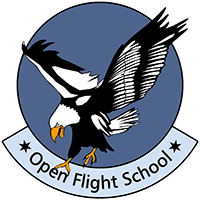Basics for Radio Communication
4. Aviation Jargon
![By Clark N S (Plt Off), Royal Air Force official photographer [Public domain], via Wikimedia Commons](https://www.openflightschool.de/pluginfile.php/610/mod_book/chapter/283/544px-Lancaster_wireless_operator_WWII_IWM_CH_8790.jpg) Personal Callsign. In addition to the radio messages between pilot and tower or air traffic control, there is a special aviation language that has established itself independently of the phrases used with ATC (Air Traffic Control).
Personal Callsign. In addition to the radio messages between pilot and tower or air traffic control, there is a special aviation language that has established itself independently of the phrases used with ATC (Air Traffic Control).
It would be extremely impractical to use detailed radio messages in the middle of air combat. Usually there is only one or very few recipients of the message anyway. Usually only two airplanes or maximum 4 at the same time, at the same place, on the same frequency, are involved in the same fight. These must communicate very effectively with each other. This starts with the pilot personal callsign. The best known of these are: “Maverick”, “Jester”, “Viper” or “Goose”. All short two-syllable words. A long badly pronounced name as a callsign is a hindrance.
Brevity Code Words. For certain things and observations there are simple abbreviations called Brevity Code Words. The term “Angels 20” is faster and also unique. Alternatively one could say also "Level 20 thousand". "Fire spell" is nothing else like "I see Flak or other projectiles in the air". Or "Tally Ho!" is faster to say than "I engaging the enemy".
Many teams of virtual pilots go so far that they explicitly insist on this vocabulary. Nobody wants to hear "I'll shoot an infrared rocket on the left side of the target".
We would like to point this out here in the basic theory course, but do not make it mandatory in the respective aircraft courses. But especially in the WWII scenario it brings a lot of feeling into the simulation. With the more modern airplanes it is also desirable and usually easily connected with general English aircraft radio speech.
